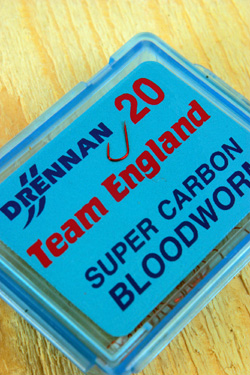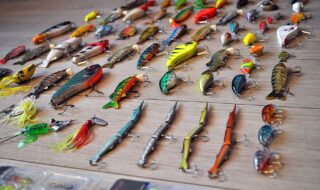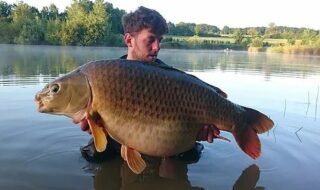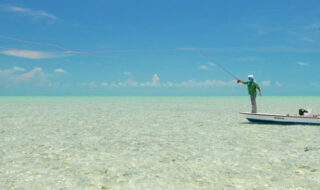Here we explain the best tackle and rigs to employ when fishing with bloodworm and joker..
IN the main, bloodworm fishing is conducted within 18 inches of the bottom – there are times when this isn’t true but these tend to be few and far between, simply because this is where bloodworm and joker are to be found.
To this end the majority of rigs tend to be fairly positive with regard to how they’re shot. However, this positive approach to shotting the rig doesn’t necessarily mean they’re crude. Far from it, bloodworm is regarded as the one bait that demands attention to detail. The small size of the bait means that, on most occasions, an untidy rig will damage your catch rate.
Bloodworm and joker fishing usually takes place during the colder months when fish are not so willing to feed and, because waters are clearer, they tend to be quite wary. This is why finesse can be vital. However, the important thing is to balance your rig to detect every bite and help you connect with every fish.
Here we run through all the bits and pieces that you will need when approaching any ‘worm’ match.
 |
Hooks
There are several excellent hook patterns on the market for use with bloodworm and joker but the big question has to be whether to use barbed or barbless? Obviously this decision is made for you on the majority of commercial fisheries by the fishery’s rule board, but on natural venues how do you make the choice and why?
The argument for barbless is that, as the bloodworm and joker are small, fragile baits, by using a hook without a barb you will damage the bait less, allowing it to work better and for a longer period of time. This has to be balanced against possible fish loss. For instance, when shipping in, especially when fishing very long, you may have to break down twice and this could result in more lost fish due to a slack line if using a barbless pattern than when using a barbed pattern.
As with all fishing the hook has to be balanced to the target species. While a very fine wire hook allows for a better presentation for roach and perch it will be of little use on a commercial venue where small carp, F1 hybrids and tench are the quarry. For these species you’ll need a stronger hook that is finely balanced, giving enough strength to land the occasional better fish without damaging the bait and affecting presentation too much.
Elastics
In the main, elastics tend to be generally quite light compared to fishing other baits; this is in line with the rest of your gear.
Try threading your larger elastics – No3 and above – through the top three sections of your pole, this allows you to use slightly heavier elastic and cuts down on the number of lost fish. Bear in mind the fish you are catching will be cold and sluggish and unlikely to tear off when hooked. Below is a table outlining a rough guide to elastic choice.
The Right Elastic
Canals, drains – sizes 1 to 3
Stillwater (small fish) – sizes 2 to 4
Stillwater (bream, roach) – sizes 3 to 6
Commercial (carp, F1s, tench) – sizes 4 to 6
Slow-moving rivers – sizes 4 to 6
Fast-flowing rivers – sizes 6 to 10
 |
| Match the size of your float to the depth of the venue. |
Floats
There are hundreds of different float shapes on the market but when using the worm you can condense them into five basic patterns.
The choice will depend on the venue and the weather. Floats need to be as sensitive as possible while still being able to cope with adverse conditions. The most important thing is to match the size of the float with the depth of the venue. It’s no good fishing with a 1g rig in two feet of water and a 4×14 float in a swim 12 feet deep wouldn’t work either. A general rule of thumb is to start with a 4×10 float in two feet of water then move up a float size for every 18 inches of water thereafter. Using this rule, you would use a 1g float in nine and a half feet of water.
Float bristles are made with various materials including plastic, cane and wire to name but a few. However, a fibre antenna is by far the best. Don’t be afraid to take the tips out of your favourite floats and replace them with better bristles, just make sure that the join is waterproof. Wire bristles do have their uses when fishing for small fish or on a particularly hard venue but they can prove tricky to shot up.
To help shot floats perfectly it’s best to shot them so that the tip sticks to the water’s surface then use Vaseline or bristle grease to hold the tip out of the water. Another good tip is to build into the shot capacity two or three No13 shot. Then if the float takes in a bit of water you can remove one of the shot to counteract this.
Stem materials are either metal or carbon and this tends to be a personal choice. Wire is obviously heavier and part cocks the float, while carbon will not start to sink until the shots begin to take effect and are good for fishing on the drop. Always make your rigs up to a longer length than you think you will require. I generally make canal rigs up on a six-foot trace (one arm span), while all others I set up around 18 feet (three arm spans).
Body Shapes
 |
Pear-shaped body
These are best suited to stillwaters. The thin neck tapers up into the bristle, allowing the angler to continually lift the bloodworm off the bottom to simulate the bait’s natural movement.
Wire stems are usually best with a fibre bristle and are suitable in most applications. Wire bristles are also available but are usually too sensitive.
When fishing for shy bites, instead of opting for a thinner bristle, just shot the float down lower in the water, this will avoid missing bites and alleviate strain on your eyes. These floats are best suited to a commercial fishery in winter.
These floats are most effective in favourable conditions; if it is windy or the water has a tow on it, it’s best to swap to a rugby ball-shaped float.
 |
Rugby ball body
This is probably the most versatile shape made. Its best use is on slow to medium-paced rivers or drains but it also comes into play on stillwaters in adverse weather conditions.
The body shape allows the angler to hold back the rig without the body riding up. This allows the bait to ride up in the flow/tow, again simulating the bait’s movement.
Carbon and wire stems are available and the choice is up to you. The only thing to watch out for with wire stems is the flip over, when the weight of the wire takes it over the top of the float. Again, fibre tips are best; wire tips are also available but are not widely used in this country.
 |
Round bodied
These are used in fast-flowing rivers to hold back and just ease the float through at quarter or half pace. They tend to be big floats, up to 10 or even 20 grams! Sensitivity doesn’t need consideration as the fish won’t have a chance to inspect the bait, it will just grab at it as it goes past.
Thick, buoyant tips are a must to allow the rig to be dragged along the bottom, while a metal stem is usually best as its weight helps keep the float stable.
 |
Elongated body shape
This is the most effective shape to use when targeting small fish such as roach and perch on difficult venues, like clear canals or narrow drains. They’re not ideal for any other conditions than when it’s calm or when there’s little breeze. If you want to add to their sensitivity, wire bristles can be advantageous.
These thin-bodied floats can become unstable in windy conditions but are deadly when the fishing is hard. Use these floats in conjunction with fine lines, small hooks and joker hook baits.
 |
Pencil shaped
These are a specialised shape and can be difficult to obtain as they are used most often on the Continent. They were originally designed for catching bleak shallow but some anglers use them for fishing whips for gudgeon and perch.
The thin shape of the float allows the angler to continually lift the float quickly out of the water and offers little resistance, allowing for a clean strike. The bristles tend to be quite short, as you are not usually looking for bites on the drop.
As you tend to use these at close range there isn’t such a need for stability and for this reason they tend to have a very short metal stem.
 |
| With very light floats you can’t use a thick rig line. |
Line
As with all rigs, the correct line choice can be critical to getting the most out of your bloodworm and joker. Always tailor your main line to the size of your float because it will help to create a balanced rig that will be suited perfectly to the venue and your target species.
For example, when using delicate 4×10 or 4×12 floats use a main line no heavier than 0.09mm. There will be very few instances when a float this light will be required for heavier work. A lighter line will complement the float because the shot will be able to settle properly and the rig will work effectively, showing every delicate pluck at the hook bait.
For larger floats of 4g or so it needs to be at least 0.14mm. Big floats, especially when fished in deep water, require a lot of weight down the line and you need to use a line that will not be easily damaged on the strike or when playing fish.
For hooklengths, think about the size of fish you are targeting and match it accordingly. Fluorocarbon is now widely used as a hooklength material so give it a go. It’s very supple and virtually invisible in the water, which always helps when fishing clear, winter venues.
Bloodworm rigs for different conditions
Calm Conditions (small fish)
In ideal conditions the float to use is the elongated body shape. This allows for maximum bite detection. Your main target fish on a canal, drain or small lake are roach and perch and are likely to be difficult to catch.
The smallest float to match the depth should be selected. Use a light main line of 0.09mm up to 1.5g then step up to 0.11mm. On the lighter rigs up to 0.50g use strung-out shot starting with No10s down to No12s, on the heavier rig use an olivette with three or four No10 droppers.
Aim to use a hooklength that is two or three sizes below your main line breaking strain. Hook-wise, for bloodworm use a size 20 or 22 fine wire and with joker try a size 24.
Gudgeon
For gudgeon us a pencil-shaped float in conjunction with a whip, usually up to five metres in length.
A fairly robust main line (0.09mm at least) should be used, even though the target fish are small, as it tends to be an abrasive method – there is no elastic acting as a shock absorber – and lines need to be bigger than those usually used.
Shot your float with either shot or olivette with a single No9 as a dropper. Bloodworm is the number one bait for these greedy little fish and a size 20 barbless tied to a 0.08mm hooklength is ideal.
Have several whips set up if possible, as gudgeon tend to move in and out as a shoal.
Commercial
This type of fishing is becoming more and more common as commercial carp waters open up to bloodworm during the winter months.
Target fish range from small roach, perch and skimmers, through to F1 hybrids, tench and carp. With this in mind, tackle needs to be ‘beefed up’ to more than you would normally use. Choose a reliable 0.11mm main line, as this will allow you to step up to a 0.10mm hooklength, but still isn’t too thick to hinder presentation if you move down to a 0.06mm bottom.
Hooks need to be stronger than the ‘normal’ fine wire to cope with that bonus tench or bream. Try a size 18 to begin with and a bunch of bloodworm on the hook. Start with the droppers strung out but if you are getting plenty of bites push all the shots together just above the hooklength.
Set your rig to fish just on the bottom, as bites on these fisheries tend to be extremely shy.
Pacey Rivers
There aren’t many venues in this country where this type of fishing is possible but places like the Avon, Severn, Thames and Don would respond to this approach.
Everything needs to be stepped up including elastics. You need to be able to hold back the float and ease it through the peg without it rising up against the flow.
Line needs to be heavy to cope with the strain and as the target fish are likely to be chub or bream, err on the heavy side when selecting a hooklength.
Thick plastic, or even cane bristles, need to be used to aid buoyancy and to stop the float dragging under.
Summary
In short, pick the right shaped float for the right conditions. If the wind gets up change the float size or even the pattern to allow the correct presentation.
It’s very easy to just plod along with the rig that you started with. All that happens is that you struggle to make it work and the end result will be less fish. Nowadays, all competitors are more than capable of winning from a good peg, don’t let them steal a march on you by your being lazy – change to keep in touch with the fish.
Don’t forget to have plenty of hooklengths tied up so you can change hook sizes to match different bait sizes.
A lot of people appear daunted by using bloodworm and joker – don’t be – it’s one of the easiest methods out there and it’s not just for small fish – carp, tench and bream love them as well – especially in the colder months.
Top Tips
Don’t be afraid to use big shots as droppers. A lot of top anglers use No10s most of the time as it helps see when a fish intercepts the bait before it hits the deck. However, build two or three No13 shot into your rig. This will allow you to adjust if the float takes on water.
Use the lightest float you can get away with, unless it’s absolutely solid. It will definitely result in more bites from fish such as roach and perch.
Make your rigs up on a long line, then when you draw that deeper-than-usual swim you won’t have to add line to the top of the rig.
Choose the correct shape of float for the venue and conditions but don’t be afraid to size up or down, or even change the pattern as the conditions alter.





